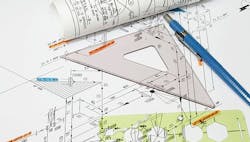The construction foreman probably thought the engineer who worked up the piping and instrumentation diagram (P&ID) was an idiot. It showed a ¾-in. pipe connected to a 24-in. cooling water line with a reducer. Just imagine how that would work: the smallest reducer in a 24-in. pipe is 6-in. Then, you probably go to 3-in., followed by a reducer to 1-in, and, finally, you get to ¾-in! I actually have seen such a monstrosity. Going with the reducers will take eight welds and require two welders the better part of a week for construction and installation. How would an old salt like me do it? Drill a hole in the 24-in. pipe and install a coupling; you can either thread it or make a socket-weld out of it.
In editing P&IDs, you should know when not to use reducers. I keep a table handy that lists the minimum-size reducers for each pipe size. This is just one shortcut in editing.
Another is identifying where flanges are missing. Far too often I have seen a pipe directly connecting to a tank or heat exchanger. For instance, I recently was editing a drawing with a molten-product storage tank. Even the general arrangement (GA) drawing for the tank showed the vessel was delivered without a flange; the nozzle schedule said “pipe.” I knew better and insisted on adding a socket-welded valve with a flange when the tank was installed. Generally, though, anything smaller than 1½-in. doesn’t require a flange. I have seen ½-in. flanges but they’re so rare that I usually review the equipment drawings and want to see the connections for myself.
Also, it’s worth noting that thermocouples and resistance temperature detectors generally go into ½-in. thermowells. Often, these thermowells are socket-welded into vessels like distillation towers or evaporators. In rare cases, you’ll see a flanged thermowell or a thermowell that’s socket-welded or threaded into a flange. In pipe, the connection nearly always is a female national pipe thread (NPT) using polytetrafluoroethylene tape as filler for the threads. It’s important to know the plant standards: companies like to solve a problem once and then repeat using that solution.
As for pressure connections, gauge or instrument, ½-in. is most common; the connection generally is a coupling for pipe or equipment.
[pullquote]
Sometimes, you’ll come across a larger NPT connection but you know it’s threaded into a smaller pipe. Generally, a “hex bushing” is the piper’s choice. So, you’ll see a 1-in. coupling connected with a 1×½-in. hex bushing to a nipple and then to the bottom or back of a pressure gauge. Once you get some experience “stringing” pipe together, it’s fairly easy to know how pipe should look on P&IDs. For one thing, anything beyond what I described would include a union to allow easier pipe orientation.
Missing mechanical drawings also are a common problem. If you can’t find the GA drawing for one tank or vessel look for a “sister” drawing for equipment bought at the same time.
Then, there are steam systems. First of all, nearly all control valves are a variant on a globe valve; sometimes, you’ll see V-port or even ordinary ball valves but, for steam and most process operations, globe valves rule. Second, if a 1-in. steam control valve regulates flow, a ½-in. steam trap probably is on the other side.
Gate valves may appear as the default symbol on P&IDs to represent valves but ball valves largely have replaced them, even in steam systems below 2-in. Some gate valves are used for smaller lines in steam but they are bulkier than ball valves and, so, have fallen out of favor.
And, then there’s missing equipment. Did you ever stare at a P&ID and know it couldn’t be right — like when there’s no flange or expansion joint or boot between a screw conveyor and a weigh tank above. First, nobody who builds equipment forgets that it’s hooked up to something else; there will be a flange. Second, how’s a scale supposed to work if it’s welded to the equipment around it. Expansion joints and boots are crafted elastomers that are difficult to replace; you want them on your P&ID, if only for inventory purposes.
Mechanical details are crucial on a P&ID. They are every bit as important as the instruments.
DIRK WILLARD is a Chemical Processing Contributing Editor. You can email him at [email protected]
About the Author

Dirk Willard
Contributing Editor
DIRK WILLARD is a former ASBPE award-winning columnist for Chemical Processing's Field Notes column. During his 10+ years as a contributing editor for CP, he wrote hundreds of valuable and insightful pieces on design and operational issues. He retired in 2023.
